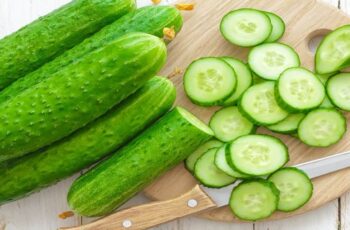Ad Blocker Detected
Our website is made possible by displaying online advertisements to our visitors. Please consider supporting us by disabling your ad blocker.
When it’s harvest time for tomatoes, I think there should be a celebration. Perhaps a federal holiday should be declared. I love this fruit so much, and I know I’m not the only one. There are a multitude of ways to prepare tomatoes from dried to roasted, to stewed, canned, even frozen (as many as there are tomato varieties).
But unless you go to a farmer’s market, the tomatoes you purchase are likely picked well before they’re ripe, and there’s nothing like a freshly picked vine-ripened tomato. Which is likely why so many gardeners grow their own tomatoes. The problem is, of course, when to harvest tomatoes. There are various schools of thought.
Ideally, the best time to pick tomatoes is when they are ripe on the vine, but how do you know if the fruit is ripe? Tomatoes are sneaky. We’re used to purchasing vibrant red tomatoes from the grocers, but the fact is that color is not a good indicator of when to pick tomatoes. If you wait until the fruit is uniformly right, it might actually be too late! Keep reading to learn when to pick tomatoes at their peak.
Picking the Best Tomato
If you’ve ever had a vine-ripened tomato fresh from the plant, you know the flavor is succulent, sweet, and full of that unmistakable tomato flavor. Tomatoes from the grocery store often pale in comparison, and there are a couple of reasons.
First, those tomatoes are often packaged and shipped hundreds of miles. If you shipped a vine-ripened tomato it would likely arrive bruised, battered, and leaking all its delicious juice. Of course, this would also make the tomato susceptible to fungal disease, resulting in a moldy piece of fruit.
This means that tomatoes for sale commercially are picked when they are barely red in color and certainly not ripe. They are forced to ripen using ethylene gas and then stored in refrigeration often below 50 F (10 C), which makes for bland-tasting fruit.
Another reason for lackluster tomatoes is they are bred for certain characteristics. In the case of grocery store fruit, the goal is to get the produce to the store and on the shelves for sale before it is damaged or rotten. So farmers look for varieties with firm fruit that have been bred for storage and shipping rather than for the best flavor.
Stages of Ripeness
There are six stages of ripeness with regard to tomatoes.
-
Mature Green Stage
The first stage is the green mature stage. At this point, the fruit is almost full-sized but still green on the outside, although color may be visible inside the fruit. This is often the stage at which grocery store tomatoes are picked and then flooded with ethylene or placed in ripening rooms to promote ripening.
-
Breaker Stage
Because commercially grown tomatoes are bulk picked and harvested, they may also be picked at stage two: the breaker stage. At the breaker stage, color is evident around the blossom end of the tomato and the fruit is considered to be “vine ripe” even if the entire tomato also shows signs of yellow or green. The color change at the blossom end of the fruit indicates that ethylene, its natural ripening agent, is being produced. Benefits to harvesting at the breaker stage are lack of cracking, increased flavor, no sunscald, and no additional insect damage.
-
Turning Stag
At the turning stage, between 10-30% of the fruit’s skin is pink to pinkish/red.
-
Pink Stage
At the pink stage, the fruit is softer, and 30-60% of the fruit has color.
-
Light Red Stage
During the light red stage between 60-90% of the tomato has color.
-
Red Stage
The red stage is the final stage of tomato ripening. At this point, 90% or more of the fruit has color and can be eaten directly off the vine.
When to Pick Tomatoes for Peak Flavor
Tomatoes are gassy– I mean they emit a gas. Ethylene gas is produced by fully formed mature green tomatoes. Inside the mature green tomato, two growth hormones change and cause the production of the gas, which in turn ages the cells of the fruit, resulting in softening and loss of the green color, turning into a red shade. The ethylene increases the carotenoids (red and yellow colors) and decreases the chlorophyll (green color).
Because of this process tomatoes are one of the only vegetables — I mean fruit — that can be picked before they’re completely ripened. Harvest time for tomatoes should ideally occur when the fruit is a mature green and then allowed to ripen off the vine. This prevents splitting or bruising and allows for a measure of control over the ripening process.
When harvesting for peak flavor has another issue. If the tomatoes aren’t quite ready for your eye, but temperatures are heating up and the fruit is in danger of sunscald, it might be a good idea to pick earlier than you would like. The same goes with unseasonal cold. If a freeze is suddenly likely, it’s better to harvest the fruit immediately rather than risk losing it all.
All that being said, harvesting breaker tomatoes has a couple of advantages. It reduces the chances of insect damage, is less likely to sustain radial cracks, and will reduce the fruit’s exposure to inclement weather which can damage or bruise the delicate skin opening the fruit up to disease.
How to Avoid Splitting Tomato Skins
One of the most common problems people have with waiting for their tomatoes to ripen is splitting skins. Unfortunately, they can split at any stage of growth when they’re green or ripe. In many cases, tomatoes splitting their skins is related to inconsistent watering.
Tomatoes are very thirsty plants. They need at least 1 inch of water per week and plenty of nutrients as well. Once they start growing fruit, they use up even more water to create those lush tasty toms. Make sure your tomatoes are getting consistent watering while the fruit is ripening. A layer of mulch will help retain moisture in the soil as well, so they have less water and heat stress.
Tomatoes grown outside can be at extra risk of splitting. When they experience drought conditions, the flesh may grow faster than the skin, making it get very tight. It’s very common for water-stressed tomatoes to split their skins after a sudden rainstorm, which is not uncommon in Powell River.
So if your tomatoes are nearly ripe and rain is in the forecast, it may be best to pick them and let them finish the ripening process indoors. Tomatoes grown indoors or in a greenhouse may also split.
Don’t despair if you do discover your tomatoes have split. They are still usable. Pick split tomatoes as soon as possible, and check them for any signs of pests nibbling or tunneling into them. If no one else has been chewing on them, then you can still eat them. Make sure to use them up quickly as they won’t keep as long as other tomatoes.
If you catch split tomatoes right away, they’re still fine for slicing or eating fresh. If you think they’ve been split for a day or two, they’re probably better for cooking. Even if they’ve been nibbled on, you can still save the seeds from them for next year if you like the variety.
How to Harvest Tomatoes
There is a fine line when picking tomatoes at the mature green stage. Look for the first light blush of color. Of course, you can also harvest tomato fruit when it is ripe — ripe fruit will sink in water. These vine-ripened tomatoes may be the sweetest, but some types of tomatoes are too heavy to vine ripen, hence picking tomatoes at their mature green stage and allowing the ethylene gas to continue the ripening process.
The “how” to harvest tomato fruit is pretty basic. Watch the bottom of the fruit carefully, as this is where tomatoes begin to ripen, especially large heirloom varieties. Lightly squeeze the fruit to test for firmness. Once the first bloom of red appears on the skin of the tomato, harvest time for tomatoes is nigh.
When you’ve taken all this time to nurture your tomatoes, you don’t want to just rip them from the vine and damage them. Instead, use good sharp garden snips or shears to cleanly slice the stalk just above the calyx that has formed to protect the bud.
If your tomatoes are in the red stage and couldn’t get any riper and/or you plan on eating them immediately, you may choose to remove the fruit by twisting it away from the stem.
How to Ripen Tomatoes after Picking
As mentioned above, tomatoes do ripen after they are picked. Picking at color break and then refrigerating can extend a tomato harvest by several weeks. This stops ethylene production and essentially puts the fruit into temporary stasis.
Some gardeners eschew the refrigerator and instead lay fruit in a single layer in cardboard boxes in a dim room, or wrap each tomato in a newspaper or waxed paper. Other growers hang entire plants — a practice practical in the humid East. Still, others simply place tomatoes at the color break stage on the kitchen counter. Whichever way you store the tomatoes, check them every few days for ripening or spoiling. Room-temperature tomatoes should ripen within 5-7 days.
To ripen your tomatoes more rapidly, place them in a paper bag with a banana, or other already ripe tomatoes. Both the ripened fruit and banana give off ethylene gas, a ripening compound that will hasten ripening.

